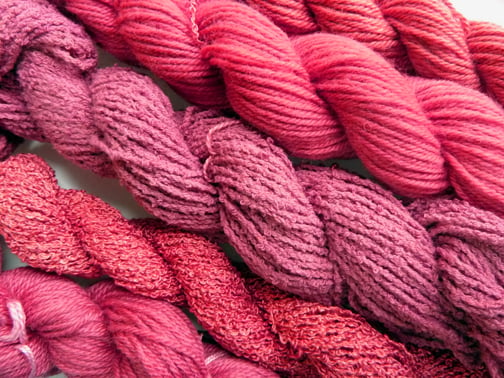
Each week, we are emailed with questions from our natural dye community asking simple and complex questions that we thought might be worth sharing. Here are a handful from this week answered by natural dyer in chief, Kathy Hattori, Founder of Botanical Colors:
I would like to be able to make variegated yarn from a finished skein (as opposed to spinning my yarn from various colored fibers, which is what I do now). I’ve done most of my dyeing on wool that I spin and then weave, but would like to dye cotton and hemp fabric. I am not able to get intense colors. Thanks for any pointers you can give!
There are a few techniques to create variegation on yarn skeins. One way is to create concentrated solutions from the dye extracts (except indigo) and paint them onto a mordanted skein that’s placed on a piece of plastic wrap. You can apply the color in any area that you choose and then steam set the colors using a covered dye pot with a canning rack and water bath. Make sure the skein stays above the water and steam for 45 minutes. Remove carefully, let dry completely, then rinse and dry.
I am looking for a nice pink or purple dye for cellulose fibers- recommendations?
Any of the insect dyes (cochineal or lac) will give a strong pink. You can shift the color to purple with the addition or iron, or by under dyeing with indigo first, then mordanting and dyeing with cochineal or lac. Proper scouring and cellulose mordanting will ensure a rich color.
I’m interested in ordering the Botanical Colors natural indigo dye. I’d like to dye some cotton/linen fabric and discharge print it with bleach paste, but I’m looking for a more natural way to do this. Do you know of a natural color remover that I can thicken and screenprint with, that will work well with your indigo? I’d like to remove all color in the printed areas so that it’s white.
We do not recommend using bleach paste for color discharge as it can damage most natural fibers and is considered toxic. Most of the conventional indigo discharge chemicals are not natural, must be handled with care, and it is difficult to control the color removal process. It is possible to create a strong resist by making a Japanese style katazome paste and apply it to the fabric, then dip in indigo. The paste is thick enough to withstand indigo dipping and then washes off easily. Tien Chiu studied with John Marshall and has a detailed recipe for making the paste.
Do you have any suggestions for doing an easy resist using the 1-2-3 vat?
Mechanical resist techniques such as folding and clamping (itajime shibori) and simple binding are very easy and create beautiful results. If you want to use a thickened paste, then make a katazome paste as above.

